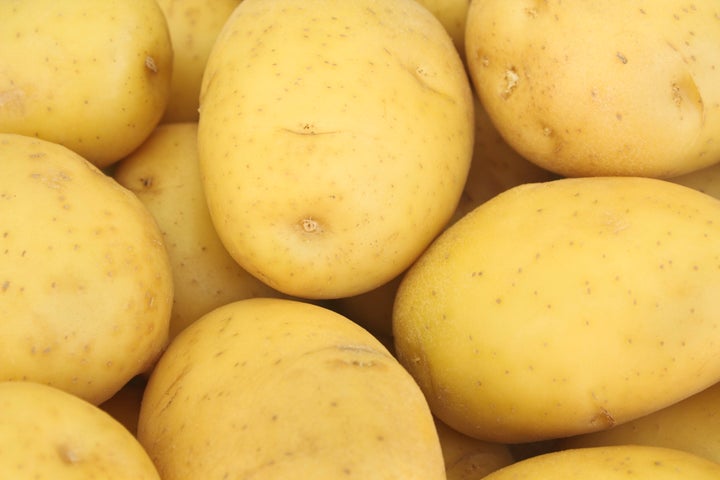Food scientists and chefs agree that some spuds are simply better-suited for potato salad.
Water-logged, mushy and mealy is not what we’re after in a good potato salad, and choosing the right spud for the job can help you avoid that. After talking to food scientists and chefs, we’ve found the three best kinds of potatoes for the job, based on flavor, texture and simplicity when making this dish.
The Science Of Potatoes
While there are over 500 varieties of potatoes worldwide, spuds can be broken down into three main types: waxy, all-purpose and starchy. And when it comes to starch, there are two types of starches in potatoes: amylose and amylopectin. Amylose creates a fluffy spud once cooked, while amylopectin helps the potato hold its shape.
Because a classic potato salad is boiled, avoid starchy potatoes. Instead, reach for waxy or all-purpose potatoes, which contain more amylopectin than fluffy, starchy potatoes and will hold their shape.
Amanda Frankeny, a registered dietitian and program director of the Food Dignity Movement, explained, “New potatoes, red varieties or fingerling potatoes have more water and less starch than starchy potatoes, and a higher proportion of that starch is amylopectin. They make a gummier, denser product … and they do hold together when boiled.”
Ali Manning, a food scientist and owner of Umami Food Consulting, also recommends sticking with waxy or all-purpose potatoes the next time you whip up a classic potato salad. She explained, “the composition of the starch granules in waxy potatoes allows them to maintain their structure better during boiling.”
Though starchy potatoes like russets, Idahos and sweet potatoes are typically a go-to in many American households, you should reserve those for baking and mashing instead of for potato salad.
Manning explained that they aren’t a great choice due to their high starch content.
“It boils down to the starch-sugar conversion,” Manning said. “Potatoes with higher sugar and starch content prevent them from maintaining their structural integrity at higher boiling temperatures. A russet or sweet potato could likely leave your potato salad mealy and mushy.”
Here are the specific types of potatoes the experts do like.

Yukon Gold Or Red Potatoes
Mike and Mark Black, Texan chefs and co-owners of Terry Blacks BBQ, are big fans of Southern-style potato salad ― creamy and tangy with lots of texture in the potatoes ― and their recommendation is either a Yukon Gold or a red potato for the job.
“Both of these potatoes hold their shape very well,” Mike Black said. “With thinner skin, high moisture and low starch content, when mixed with the dressing, the potatoes don’t oversaturate and break it down. The red potatoes have a sweet undertone derived from [their] natural sugars, adding better flavoring to the potato salad.”
Since Yukon Golds aren’t as widely available in grocery stores, the duo suggested going with red potatoes in a pinch. If you can source Yukon Golds, the potato is favored for its flavor and superior structure once boiled.
Frankeny explained, “Yukon Gold potatoes are a great middle ground. They fluff and flake like the starchy variety but still hold their shape when boiled like a waxy potato.” All-purpose potatoes can go into any potato salad recipe that calls for waxy or starchy varieties.

New Potatoes
Small and round, new potatoes are freshly harvested and uncured (a storage process most potatoes undergo to set and last longer). These spuds typically are sweeter and smaller, perfect for boiling or steaming whole.
Rhoda Boone, the culinary creative director for MadeIn Cookware, said, “Waxy potatoes like new potatoes hold their shape and tend to absorb less water when boiled. They have such soft, thin skins you don’t even have to peel them, plus the skins look pretty in a salad.”
When shopping for new potatoes, look for smooth skin and firm flesh. Squishy potatoes with sprouted eyes should be avoided.
Another benefit to choosing new potatoes is their super-absorbent skin. “Once the potatoes are cooled and dressed, the permeative skin and starch absorb the added ingredients for a better taste,” Manning said.

Fingerling Potatoes
Another waxy type, fingerlings are small, stubby and sausage-like. They come in various colors, and like new potatoes, their mini size makes this ideal for cooking whole.
Sarah Farmer, a chef and photographer behind Gumption Studio, prefers fingerlings for her potato salad but likes to take a different approach to cooking.
“I love using fingerlings because they have a great flavor and texture and provide an elevated look to what is a simple dish,” she said. “I love to cook fingerlings in a campfire; there is so much opportunity to build flavor when you roast potatoes in the fire and finish in a cast iron. You get some smokiness from the fire, while the cast iron gives you caramelized potato flavor with crunchy bits.”
These small potatoes can be eaten or added to your salad whole, making for less prep work, according to chef Dario Jurecvic, who endorsed the spuds. He recommended keeping the skin on while cooking to help the potato hold its shape and starting with cold water to help the potato cook evenly. “I like to sear fingerlings off in an infused butter, which elevates the potatoes’ flavor before adding a dressing. You can also grill or sear to caramelize potatoes which is a great way to add flavor and texture to the salad.”
More Potato Salad Tips
Don’t forget to wash your spuds thoroughly before cooking. Farmer suggests soaking sliced potatoes in water with salt and vinegar to enhance the natural flavor, followed by a quick rinse before cooking.
Jurecvic suggests cooling your potatoes before dressing, as this will also help the spud hold its shape. “It is so important to cool completely, even placing them in the fridge before cutting,” he said. The dressing will cling to dried potatoes better, so pat the potatoes dry after boiling or steaming them.
Credit: Source link